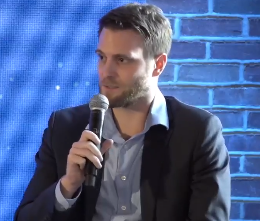 Google Glass is Google’s latest awesomely terrifying innovation.
Google Glass is Google’s latest awesomely terrifying innovation.
It’s basically a pair of dorky glasses that function as a high-definition video camera wherever you go.
The footage you record can be shared virtually with friends, in real-time.
Friends who you can see in the corner of your screen.
Sorry, they’re glasses. I mean world.
Although when you wear glasses that are a screen, the whole world becomes a screen.
The next logical step is finding a way to make stylish glasses. After that, Google will need to make contacts that can project a screen – which is already happening.
But what’s after that?
The hysteria of online America
While the government seems to be collapsing, the economy is interminably teetering on another recession (at least for the middle class), and our infrastructure is looking more and more like the ruins of a once-great civilization, the tech sector is doing fine.
Even as more Americans get priced out of the latest technologies and therefore the latest economies, technology companies continue to innovate.
Google Glass holds a world of very intriguing and very scary potential:
- What is a world like when you can record your most treasured moments?
- What do you do when you can press a button and experience those moments in 3D?
- How are our memories altered when we know they can be cataloged, stored, and relived in full detail?
Memories are becoming commodities
We can see people commodifying their memories on social media.
They take brilliant pictures on Instagram and post them in hopes of Likes. They dress their Timelines and photo albums with the best of their own personal lives.
Google Glass will complement this process.
As with all social media, you won’t see what your friends are doing, you’ll see the things they do that they hope everyone thinks they’re doing all the time.
Hence the Google Glass videos of torch jugglers, sky divers, and horse-riders. I didn’t see a single video of someone stuck in rush hour traffic on their way to their cubicle.
It’s interesting to see such intensive moments from the first-person perspective. It hasn’t been done before and it could be a strangely unifying human experience.
Sure, we can’t feel what the people are feeling or think what they’re thinking, but our imaginations are very good at creating stimulation from simulation.
I wonder if people will be able to download these memories and experiences from an app store.
Those moments will just be video files, anyway. Maybe the most intense ones will be the highest priced.
The scarier part
We’re only going to share the moments we record that we think will excite the world, but we’ll be recording a lot of private moments, too.
Your first kiss. Your first love. A romantic night on the beach. A vacation in the Bahamas. A trip to Scotland.
With big data and cloud technology, these videos will be able to be days, weeks, months long.
These are the private moments that we will be able to relive in full detail.
But how will we relate to the present when we can so easily relive the past?
I wrote a short story, “Memory Board,” about this topic, narrating the life of one woman who uses videos to relive a teenage romance, over and over and over.
In it, everyone owns a pair of mySights, which are the equivalent of Google Glass in contact lens form. A company called Shiny Red creates a feature called MakeItLast, which allows people to record their private moments.
Building off the success of that feature, Shiny Red creates myMemory, which allows users to send video clips to memory engineers who then create a fully sensory experience around that memory using Shiny Red’s latest invention: the memory booth.
“Lines formed at every booth. Time limits had to be imposed. The very wealthy had private memory booths built at home. Some savvy entrepreneurs created memory cafes, where you could have coffee with a friend and reminisce about a great memory, before plunging into that memory and experiencing it again and again. Retired athletes reveled in the games of their lives, over and over. People who had reached the ripe retirement age of 75 spent all day in the booths, remembering what it felt like to be young and strong. A controversial product from Night Dreams that was co-sponsored by The Global Medical Corporation appeared in the market: The Ejection. “Just a painless prick at the right moments will really help you relive those memories, whether it’s a long night at the bar or a long night in the bedroom!” the Night Dreams spokeswoman assured people.
For Sarah, the memories were a luxury. She saved up for months on end, edited the video of her trip to Germany with Evan, squashing to five hours, and sent it to the memory engineers at Shiny Red.”
The problem with reliving the past so fully is that you’ll still never, ever know your thoughts and feelings at the time.
You’ll romanticize those moments, polish and perfect them, and convince yourself that you were euphoric during the videos. You’ll be convinced that you’ll never be as happy as you were at the time.
I wonder if these moment-recording-commodifying miracles are really just going to make nostalgia become an epidemic.
 If you want to read the full version of (ahem, Pushcart-prize nominee) “Memory Board,” check out my short story collection, “Technology & Culture Stink!”
If you want to read the full version of (ahem, Pushcart-prize nominee) “Memory Board,” check out my short story collection, “Technology & Culture Stink!”
It’s got 16 other stories and they’re all pretty good, if I can’t say so myself. Which I probably can’t.

Leave a comment